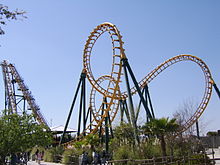
A roller coaster is a type of amusement ride employing a form of elevated railroad track that carries passengers on a train through tight turns, steep slopes, and other elements designed to produce a thrilling experience. Trains consist of open cars connected in a single line, and the rides are often found in theme parks around the world. Roller coasters first appeared in the 17th century, and LaMarcus Adna Thompson obtained one of the first known patents for a roller coaster design in 1885, based on the Switchback Railway which opened a year earlier at Coney Island.

Vekoma Rides Manufacturing is a Dutch amusement ride manufacturer. Vekoma is a syllabic abbreviation of Veld Koning Machinefabriek which was established in 1926 by Hendrik op het Veld.

A roller coaster inversion is a roller coaster element in which the track turns riders upside-down and then returns them to an upright position. Early forms of inversions were circular in nature and date back to 1848 on the Centrifugal railway in Paris. These vertical loops produced massive g-force that was often dangerous to riders. As a result, the element eventually became non-existent with the last rides to feature the looping inversions being dismantled during the Great Depression. In 1975, designers from Arrow Development created the corkscrew, reviving interest in the inversion during the modern age of steel roller coasters. Elements have since evolved from simple corkscrews and vertical loops to more complex inversions such as Immelmann loops and cobra rolls. The Smiler at Alton Towers holds the world record for the number of inversions on a roller coaster with 14.

An inverted roller coaster is a type of steel roller coaster in which the train runs under the track with the seats directly attached to the wheel carriage. Riders are seated in open cars, letting their feet swing freely. The inverted coaster was pioneered by Swiss roller coaster manufacturer Bolliger & Mabillard in the early 1990s with the development of Batman: The Ride, which opened at Six Flags Great America on May 9, 1992.
Anton Schwarzkopf was a German engineer who founded Schwarzkopf Industries GmbH, a German manufacturer of roller coasters and other amusement rides that were sold to amusement parks and travelling funfairs around the world.

Arrow Dynamics was an American manufacturing and engineering company that specialized in designing and building amusement park rides, especially roller coasters. Based in Clearfield, Utah, the company was the successor to Arrow Development (1946–1981) and Arrow Huss (1981–1986), which were responsible for several influential advancements in the amusement and theme park industries. Among the most significant was tubular steel track, which provided a smoother ride than the railroad style rails commonly used prior to the 1960s on wooden roller coasters. The Matterhorn Bobsleds at Disneyland, built in 1959, was Arrow's first roller coaster project.

Intamin Amusement Rides is a design and manufacturing company in Schaan, Liechtenstein, best-known for designing and constructing thrill rides and roller coasters at dozens of international theme parks, amusement parks and other establishments. The Intamin brand name is a syllabic abbreviation for " international amusement installations". The company has corporate offices across the world, including three in Europe, three in Asia, and two in the United States.

The launched roller coaster is a modern form of roller coaster. A launched coaster initiates a ride with high amounts of acceleration via one or a series of linear induction motors (LIM), linear synchronous motors (LSM), catapults, tires, chains, or other mechanisms employing hydraulic or pneumatic power, along a launch track. This mode of acceleration powers many of the fastest roller coasters in the world.

Boomerang is a model of roller coaster manufactured and designed by Vekoma, a Dutch manufacturer. The roller coaster model name is from the hunting implement based on the traditions of the Indigenous Australians. As of January 2023 there are 55 Boomerangs operating.

A Giant Inverted Boomerang is a type of steel shuttle roller coaster manufactured by the Dutch firm Vekoma. The ride is a larger, inverted version of Vekoma's popular Boomerang sit down roller coasters. As of April 2024, four installations of the model are operating, with another one under construction.

Boomerang: Coast to Coaster is a steel roller coaster of shuttle design currently in use at four different Six Flags & EPR theme parks. The ride was designed and manufactured by Vekoma, and is considered as one of its boomerang models. Each coaster has one train with a capacity of 28, two across in each row. Unlike Vekoma's suspended trains, "Boomerang: Coast to Coaster" operates a sit-down design. When the coaster starts, the train is pulled backwards up the lift hill, then dropped through the loading gate through a cobra roll and then one loop. At the end of this cycle the train is pulled up the lift hill at the end of the track, then dropped once again allowing the train to go back through the loops backwards, hence the name "Boomerang: Coast to Coaster."
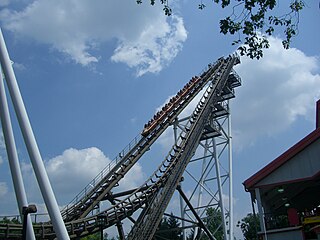
Jolly Rancher Remix is a steel shuttle roller coaster located at Hersheypark in Hershey, Pennsylvania, United States. A Boomerang model manufactured by Vekoma and designed by Peter Clerx, the roller coaster originally opened as the Sidewinder on May 11, 1991. The roller coaster debuted in the Pioneer Frontier section of the park and cost $4.2 million. The Sidewinder was the first roller coaster installed in the park in 14 years since the SooperDooperLooper in 1977 and the fourth roller coaster in operation to be built. The roller coaster has a maximum height of 116.5 ft (35.5 m), with a maximum speed of 47 mph (76 km/h), and a track length of 935 ft (285 m).
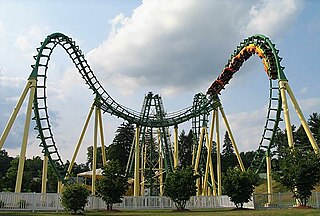
Zoomerang is a steel shuttle roller coaster located at Lake Compounce in Bristol, Connecticut. A Boomerang model manufactured by Vekoma, it contains a cobra roll and a vertical loop. Zoomerang was the first boomerang coaster to receive a Vekoma-designed train. Early models used trains designed by Arrow Dynamics. In September 2007, due to paint deterioration, the ride was repainted with a new color scheme with purple tracks and teal supports.

Shuttle Loop is a type of steel launched shuttle roller coaster designed by Reinhold Spieldiener of Intamin and manufactured by Anton Schwarzkopf. A total of 12 installations were produced between 1977 and 1982. These 12 installations have been located in a total of 22 different amusement parks.
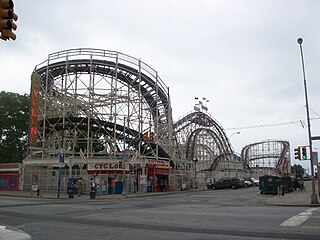
Roller coaster amusement rides have origins back to ice slides constructed in 18th-century Russia. Early technology featured sleds or wheeled carts that were sent down hills of snow reinforced by wooden supports. The technology evolved in the 19th century to feature railroad track using wheeled cars that were securely locked to the track. Newer innovations emerged in the early 20th century with side friction and underfriction technologies to allow for greater speeds and sharper turns. By the mid-to-late 20th century, these elements intensified with the introduction of steel roller coaster designs and the ability to invert riders.

Invertigo is the name of an inverted shuttle roller coaster model developed and manufactured by Dutch company Vekoma. Four roller coasters based on this model were built, with the first installation opening in 1997 as HangOver at Liseberg amusement park located in Sweden. Three of the four are still in operation. Invertigo is designed as an inverted variation of their traditional Boomerang model, which first appeared in 1984. Invertigo's seat configuration is also a departure from its predecessor, in that riders sit back-to-back, resulting in all rows facing one another with the exception of the first and last.

The Thunderbolt Express was a looping shuttle roller coaster located at Camden Park. Originally named Screamin' Demon when it operated at Kings Island from 1977 to 1987, the roller coaster was built and designed by Arrow Dynamics. It was sold to Camden Park following the 1987 season, and reopened at its new location in 1988. Following an electrical issue in 1999, the ride was closed indefinitely for a period of time. An announcement surfaced that the ride would reopen in 2002, but the roller coaster was dismantled following the 2004 season and replaced by a miniature golf course.

Energylandia is an amusement park located in Zator, Lesser Poland, in southern Poland. It is approximately 50 kilometres (31 mi) away from Kraków and 335 kilometres (208 mi) away from Warsaw, Poland's capital city. Energylandia is the largest amusement park in the country, at 70 hectares. The park has one of the highest roller coaster counts of any theme park in the world.
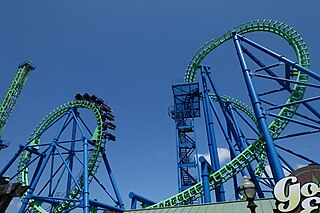
Goliath was a steel shuttle roller coaster located at Six Flags New England in Agawam, Massachusetts. Manufactured by Vekoma, the ride originally opened as Déjà Vu at Six Flags Magic Mountain in 2001. The ride was a larger, inverted version of Vekoma's popular Boomerang sit-down roller coasters. In 2021, the park removed the ride from its map indicating it would not reopen for the remainder of the season. In late 2021, demolition of the coaster began.
